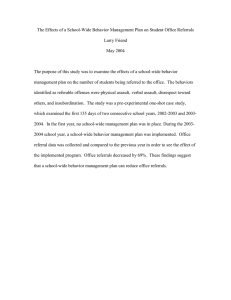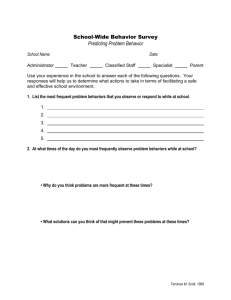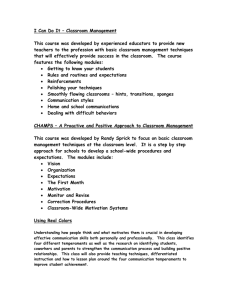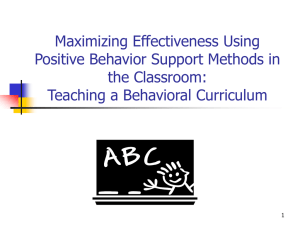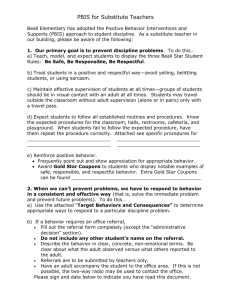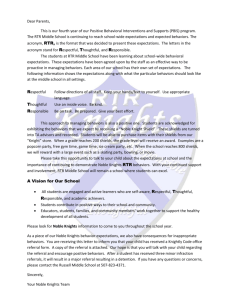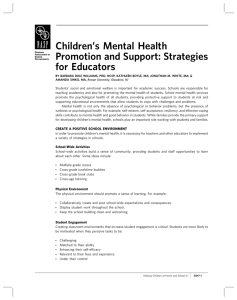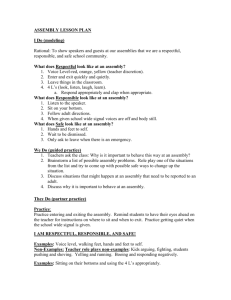Expectations and Rules - Peer Support Australia
advertisement
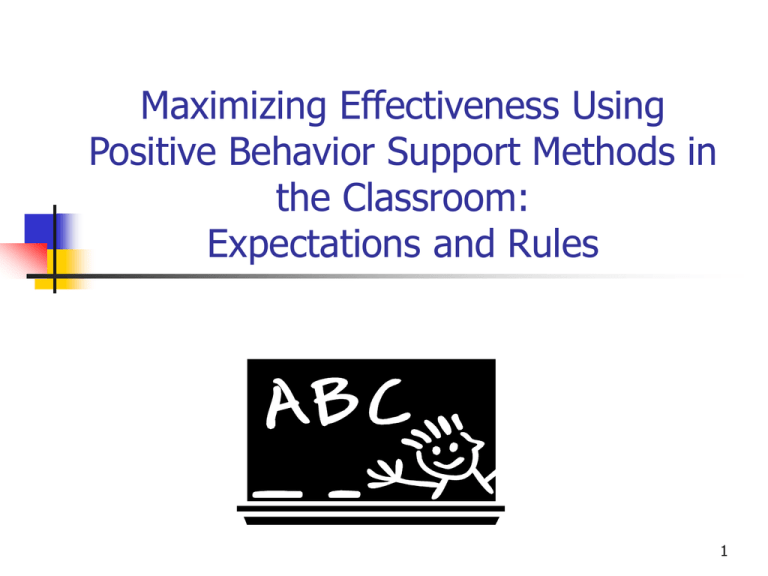
Maximizing Effectiveness Using Positive Behavior Support Methods in the Classroom: Expectations and Rules 1 Objectives Understand why expectations and rules are important and needed Understand guidelines for developing expectations Understand the differences between expectations and rules Identify strategies to determine your classroom rules Develop rules for your classroom 2 Training Expectations The 3 B’s Be Respectful Be Responsible Be an Active Participant 3 Training Rules Expectations Rules 1. Be Respectful Listen to other’s ideas Collaborate with team members Listen quietly while the speaker is presenting 2. Be Responsible Complete task Come to consensus as a team Come back from breaks and lunch on time Start training on time 3. Be an Active Participant Share ideas with others Follow through with task and activities Work on activities as a team Equal task distribution 4 Why do we need classroom rules? Keep control of the environment Provide structure in the classroom Provide the students with an enriched learning environment Keep inappropriate behaviors from occurring Provide students with consistent procedures and routines 5 How Are Expectations and Rules Similar? Both should be limited in number Both should be positively stated Both should clarify criteria for successful performance 6 How Are Expectations and Rules Different? Expectations are broadly stated Expectations apply to all people in all settings Expectations describe the general ways that people will behave 7 Differences Continued. . . . Rules describe specific behaviors - Observable - Measurable Rules may apply to a limited number of settings Rules clarify classroom expectations 8 Which Ones Are Expectations? Which Ones Are Rules? Be considerate Be punctual Place food items in their proper containers Remain seated during instruction Follow directions Keep all four legs of your chair on the floor 9 Rules for the Classroom Setting Definition: Specific skills and procedures that you want students to engage in and perform while in the classroom. 10 What Is Gained by Identifying Rules? Communication among teacher and students Assessment of student behaviors Communication with parents Curriculum design Legal, ethical, and professional accountability 11 How do you develop rules for your classroom? Individualized Consistent with school-wide system Based on assessment of your classroom Identify what problems are occurring in the classroom Identify what systems are working in the classroom Based on the student’s behaviors Based on the student’s needs Identify the skills that students are lacking 12 Guidelines: Identifying Rules For each expectation, select 1 to 2 rules (ideal) Positively stated Planned processes for participant feedback Shared ownership in development Rules should be unique to classroom needs Not to exceed a total of 6 rules 13 Take a look at Mr. Black’s class What does his data tell you? Total=28 students Last month = 51 discipline referrals Referrals summary: Disrespect = 19 Fighting = 2 Refusal to comply/follow directions = 30 Average students tardy per day = 5 Average students absent per day = 0.5 Percentage of completed assignments = 98% 14 Mr. Black’s Classroom Top 3 Problem Behaviors: Tardiness Refusal to follow directions Disrespect 15 What rules would you develop for Mr. Black’s class based on this data? 16 Here are some suggestions……….. Come to class prepared Come to class on time Bring your homework to class everyday Bring all learning materials to class Follow directions the first time Raise your hand to speak Listen to others and share ideas Use inside voices during class time Keep hands, feet, and objects to yourself 17 Perfect School’s Matrix Example: Classroom Rules Mr. Jones’ Class Mrs. Lee’s Class Be Safe Sit with your chair on all 4 legs Walk Be Responsible Bring your materials to class each day Bring your homework every day Be Respectful Keep your hands and feet to yourself Use appropriate language Talk when it is your turn to talk Ask if it is “OK” to borrow an item 18 Activity: Develop Classroom Rules Identify your school-wide expectations List your current classroom rules Do these rules meet the guidelines? Based on your school-wide expectations and classroom assessment, develop rules for your classroom Consider rules for team consistency 19

